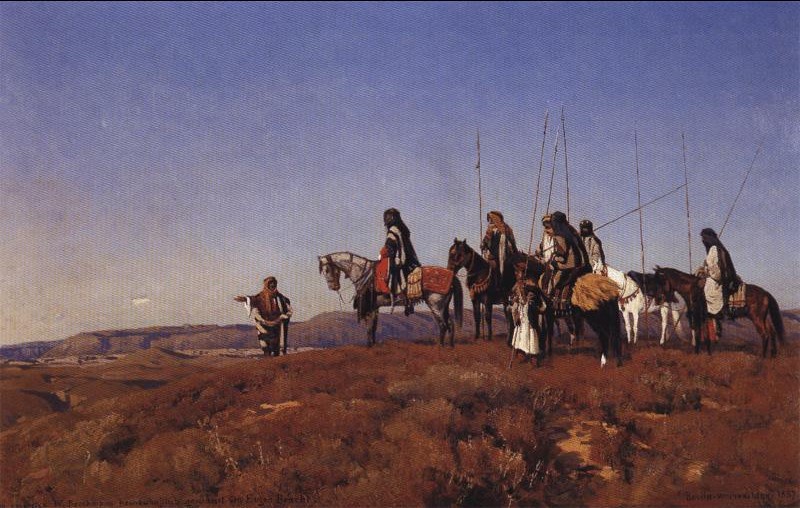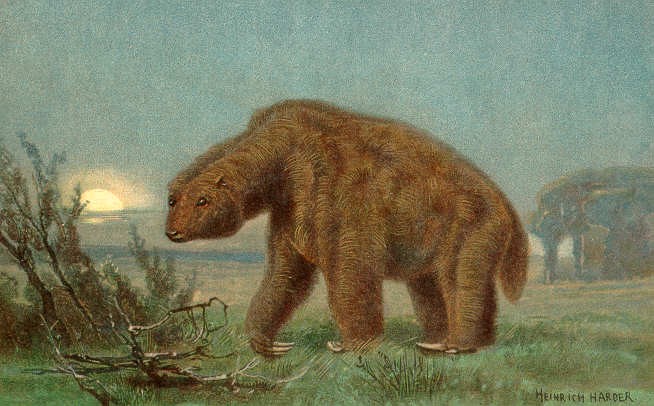'Tiere der Urwelt': Creating a ‘Prehistoric’ Landscape
by Alexander Bräuer, 04/14/2016.
Summary
What does a ‘prehistoric’ landscape look like? In Tiere der Urwelt (“Animals of the prehistoric world”), a trading card series produced by a German chocolate producer, the painter Heinrich Harder tried to find an answer to this question. The cards should depict the ‘prehistoric’ animals in their natural surroundings and communicate a realistic picture of the world in the distant past. Harder started his career as a student under Eugen Bracht, a famous painter of German and orientalist landscapes, and could therefore draw on some experience in order to create a ‘prehistoric’ landscape. Therefore, he painted a ‘prehistoric’ landscape deeply embedded in contemporary colonial and artist discourses. Because of the popularity of Harder’s paintings in the 20th and 21st century, these discourses are still influencing our ideas about ‘prehistoric’ landscapes. This article will focus on the land-locked paintings of Tiere der Urwelt.
Heinrich Harder studied at the Königliche Kunstschule in Berlin before he went on to take courses under Eugen Bracht from 1890 to 1892 whose landscape paintings had a crucial influence on Harder’s career. After 1892, Harder worked as a landscape painter in Berlin focusing on motives in the Mark of Brandenburg, Lueneburg Heath, Mecklenburg, Harz and Sweden.[1] 1906 he opened a studio for young artists and became a professor at the Berliner Hochschule für bildende Künste in 1913.[2] In 1898, Tiere der Urwelt (“animals of the prehistoric world”) was the first of many excursions by Harder into the painting of (‘prehistoric’) animals for a popular audience. He teamed up with Wilhelm Bölsche, a famous Darwinist writer, to publish articles for newspapers, children books and trading cards. Bölsche usually wrote the articles, Harder painted the illustrations. The painting of (‘prehistoric’) animals presented an opportunity to make himself known to a broad public audience and regularly earn money as a painter.
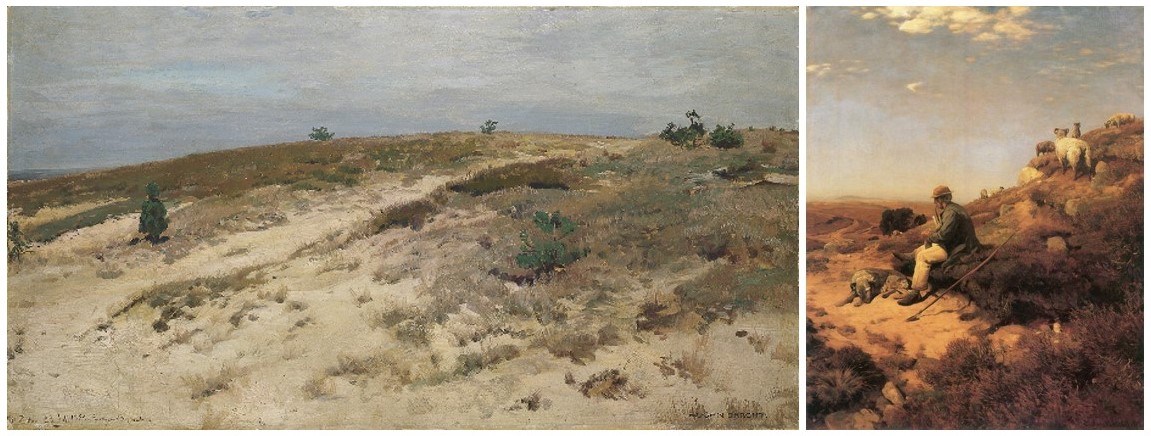
Until today Harder’s teacher Eugen Bracht is known as one of the most influential landscape painters in Germany. In 1875, he started a revival of landscape painting by introducing previously neglected landscapes like the Lueneburg Heath into the canon. In his paintings he emphasized the human relationship to nature, countryside idyll, a sense of home and aesthetic contemplation. Six years after he became known to a broader public through his paintings of landscapes, Bracht started to paint orientalist landscapes in 1881.
After traveling through Syria, Palestine and Egypt together with Carl Coven Schirm and Adolf von Meckel, two orient painters, in 1881 and 1882, Bracht used his approach on German landscape paintings for orientalist motifs. He saw his work as a continuation rather than a break from his earlier works and tried to capture the familiar moments in the strange landscape.[3]Halt on an Escarpment, for example, depicts a landscape very similar to the Lueneburg Heath. Humans, when depicted, are seen as an integral part of the nature who consistently adapt to the challenging natural conditions.[4]
Besides his influences on Harder concerning the painting of landscapes, it is important to mention two other points in Bracht’s life that may have affected Harder’s career. Bracht was fascinated by the distant past, engaged in his own excavations and was one of the first members of the German Paleontological Society in Greifswald in 1912. Wilhelm Bölsche, the writer of the texts for the illustrations on the trading cards, was also member of this society.[5] His travels allowed Bracht to combine the personal fascination with colonial environments, his passion for the distant past by visiting excavation sites, and his profession: the painting of landscapes. Furthermore, he was regularly contacted by the Stollwerck company for the illustration of their trading cards and often facilitated the commissions to his students.
The Paintings of Tiere der Urwelt
A Romantic Colonial ‘Prehistoric’ Landscape?
The landscape in Harder’s paintings is heavily romanticized. The natural environment of the ‘prehistoric’ animals is often depicted during the sunrise or sunset, creating a romantic atmosphere. Playing with lighting conditions was one important stylistic feature of romantic paintings at the end of the 19th century. Romanticism in art aimed to connect the viewer to the depicted landscape through charging (natural) features with emotional potential. Not surprisingly, Harder learned the techniques during his early career by painting the landscapes of his homeland (‘Heimat’) around Berlin. The depiction of their homeland was a popular topic for romantic painters, such as Harder’s teacher, Eugen Bracht, who was famous for his paintings of the Heath. Similar to many colonial painters, Harder created through his paintings a pre-colonial, pre-human, and ‘prehistoric’ Utopia inhabited by strange creatures. The beautiful, ordered, and (besides the depicted animals) empty landscape invited and asked for the latter human settlement. In contrast to depictions of German landscapes such as the heath, the ‘prehistoric’ landscape seemed to have unused economic potential: fertile grassland was probably the most sought after land in settler colonial societies. Furthermore, many paintings show nearby and easy accessible sources of water. The viewer of the trading cards recognized these representations of (colonial) landscape from other illustrations of the colonies, circulating not only in trading cards, but in emigration manuals, advertisement for colonization schemes or newspaper articles.
A Vast and Rich Landscape: The decadence of ‘Prehistoric’ Animals
The landscape is generally portrayed as rich, wide and easily accessible for the big ‘prehistoric’ animals. This, however, served also as the background for depicting the animals as slow, clumsy and idle (similar to many depictions of the indigenous people). In contrast to the wide landscape, they appear lazy and not dynamic or modern, thereby showing a decadence that, we must assume, consequently led to their extinction.
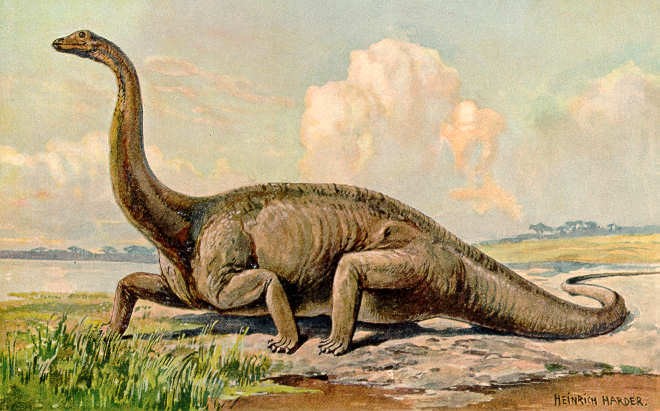
Bölsche’s texts on the verso is underlining this Darwinist argumentation that can be traced to orientalist paintings during the late 19th and early 20th century. Although most of the animals appear to move through the landscape, they do it in a slow and sometimes seemingly even confused way. The (‘prehistoric’) animals became too fat from their carefree environment and were not able to withstand the arrival of other animals superior while faster and strengthened by competition, or by humans in their habitat.
An Exotic Landscape: Colonial Vegetation in a ‘Prehistoric’ Landscape?
A common strategy for highlighting otherness in time, space, and culture was exoticism. Oriental paintings and other visual representations from the colonies created difference by portraying strange cultures and environments.
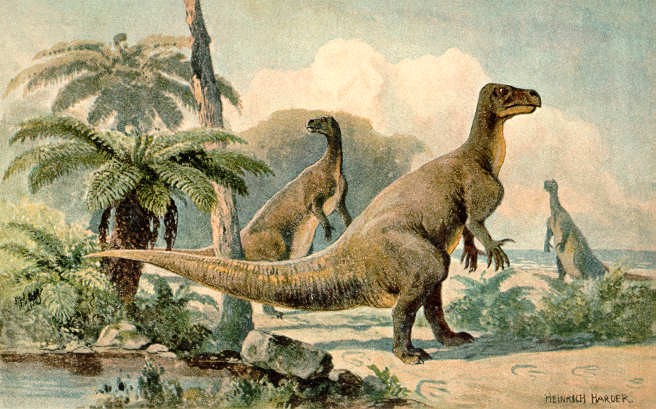
Vegetation is certainly the main marker of exoticism in Harder’s paintings. The viewer in 19th century Germany could easily recognize palm trees, ferns and tropical beaches as indicators of an exotic landscape. For obvious reasons, animals explicitly located in colonial habitats are usually depicted with an exotic environment. Nevertheless, dinosaurs constitute an exception as they were painted in exotic environments even if located in Europe. Harder and Bölsche – like other painters – were aware of the different climate in ‘prehistorical’ times and included this knowledge into their depiction/description.
Aftermath: When ‘Prehistoric’ Landscapes Became Elevated…
There is a missing element of ‘prehistoric’ landscapes in Harder’s paintings for Tiere der Urwelt: elevations or crevasses. This is remarkable because such were the locations where fossil finds were most often made. Stephanie Moser and Clive Gamble show in an article[6] that the depiction of crevasses represented an important cultural signifier for the visual representation of ‘prehistoric’ landscapes and humans since the 19th century.
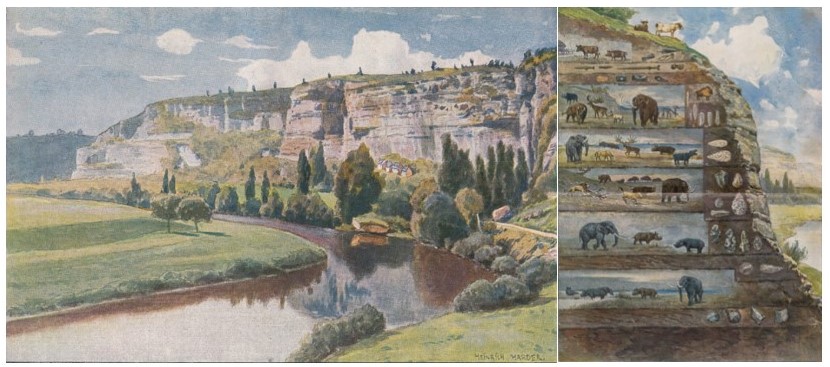
Harder was well aware of the signifier and used it prominently in his later work. Crevasses provided an effective visual depiction of time difference: every epoch could have its own place/layer in the illustrations, thereby creating a sense of historical hierarchy in the painting not unlike the stadialist theory of the progress of civilizations. However, Harder’s Tiere der Urwelt was never designed to illustrate time difference. Instead, Darwinism and its implications for a certain group of animals was the main topic. Indeed, some animals were still living and could not be assigned to any historic layer. They were ‘prehistoric’ not because of the time they were living in, but because of their assumed inferiority and expected extinction. Therefore, Harder could refrain from using signifiers of time like crevasses. For the ‘prehistoric’ landscape, signifiers of colonial difference were much more important.
NOTES
[1] Lorenz, Detlef. Künstlerspuren in Berlin vom Barock bis heute: Ein Führer zu Wohn-, Wirkungs- und Gedenkstätten. Berlin: Dietrich Reimer Verlag, 2002, p. 260.
[2] Lorenz, Künstlerspuren in Berlin vom Barock bis heute, p. 260.
[3] Rhein, Karin. Deutsche Orientmalerei in der zweiten Hälfte des 19. Jahrhunderts: Entwicklung und Charakteristika. Berlin: Tenea Verlag, 2003, p. 86.
[4] Rhein, Deutsche Orientmalerei in der zweiten Hälfte des 19. Jahrhunderts, p. 88.
[5] „Verzeichnis der Mitglieder der Paleontologischen Gesellschaft 1913.“ In: Jaekel, Otto (ed.). Palaeontologische Zeitrschrift I (1914), p. 439.
[6] Moser, Stephanie & Clive Gamble. “Revolutionary Images: The Iconic Vocabulary for Representing Human Antiquity.“ In: Molyneaux, Brian L. (ed.). The Cultural Life of Images: Visual Representation in Archaeology. London & New York: Routledge, 1997, p. 184-212.
FURTHER READING
Rhein, Karin. Deutsche Orientmalerei in der zweiten Hälfte des 19. Jahrhunderts: Entwicklung und Charakteristika. Berlin: Tenea Verlag, 2003.
IILUSTRATIONS
Figure 1: Source: https://commons.wikimedia.org/wiki/File:Eugen_Bracht_Heidelandschaft_Neu_Zittau.jpg; accessed, 04/13/2016.
Figure 2: Source: http://www.zeno.org/Kunstwerke/B/Bracht,+Eugen%3A+Der+Heidesch%C3%A4fer; accessed, 04/14/2016.
Figure 3: Source: commons.wikimedia.org/wiki/File:Halt_on_an_Escarpment_-_Eugen_Bracht.jpg, accessed, 04/14/2016.
Figure 4: Painting by Heinrich Harder depicting a Megatherium. Taken from trading card No. 2. Source: https://commons.wikimedia.org/wiki/File:Megatherium.jpg; accessed, 04/13/2016.
Figure 5: Painting by Heinrich Harder depicting a Diplodocus. Taken from trading card No. 17. Source: https://commons.wikimedia.org/wiki/File:Diplodocus_Heinrich_Harder.jpg; accessed, 04/13/2016.
Figure 6: Painting by Heinrich Harder depicting a group of Iguanodon. Source: https://commons.wikimedia.org/wiki/File:Iguanodon_Heinrich_Harder.jpg; accessed, 04/13/2016.
Figure 7: Source: Klaatsch, Hermann. Der Werdegang der Menschheit und die Entstehung der Kultur. Berlin: Deutsches Verl.-Haus Bong & Co., 1920, Tafel I.
Figure 8: Source: Klaatsch, Hermann. Der Werdegang der Menschheit und die Entstehung der Kultur. Berlin: Deutsches Verl.-Haus Bong & Co., 1920, Tafel III.

